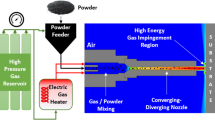Abstract
Characteristics of supersonic flow are examined with specific regard to nano-particle thin-film coating. Effects of shockwaves, nozzle geometry, chamber pressure, and substrate location were studied computationally. Shockwaves are minimized to reduce fluctuations in flow properties at the discontinuities across diamond shock structures. Nozzle geometry was adjusted to ensure optimal expansion (i.e., P exit = P ambient), where shock formation was significantly reduced and flow kinetic energy maximized. When the ambient pressure was reduced from 1 to 0.01316 bar, the nozzle’s diverging angle must be increased to yield the optimum condition of minimized adversed effects. Beyond some critical distance, substrate location did not seem to be a sensitive parameter on flow characteristics when P amb = 0.01316 bar; however, overly close proximity to the nozzle exit caused flow disturbances inside the nozzle, thereby adversely affecting coating gas flow.












Similar content being viewed by others
References
J. Akedo, Room Temperature Impact Consolidation (RTIC) of Fine Ceramic Powder by Aerosol Deposition Method and Applications to Microdevices, J. Therm. Spray Technol., 2008, 17, p 181-198
S.-Q. Fan, G.-J. Li, C.-X. Li, G.-J. Liu, G.-J. Yang, and L.-Z. Zhang, Preliminary Study of Performance of Dye-Sensitized Solar Cell of Nano-TiO2 Coating Deposited by Vacuum Cold Spraying, Mater. Trans., 2006, 47, p 1703-1709
S.-Q. Fan, G.-J. Li, G.-J. Yang, L.-Z. Zhang, J.-C. Gao, and Y.-X. Xi, Fabrication of Nano-TiO2 Coating for Dye-Sensitized Solar Cell by Vacuum Cold Spraying at Room Temperature, J. Therm. Spray Technol., 2007, 16, p 893-897
S.-Q. Fan, G.-J. Yang, C.-J. Li, C.-J. Liu, and L.-Z. Zhang, Characterization of Microstructure of Nano-TiO2 Coating Deposited by Vacuum Cold Spraying, J. Therm. Spray Technol., 2006, 15, p 513-517
A. Blais, B. Jodoin, J.L. Dorier, M. Gindrat, and C. Hollenstein, Inclusion of Aerodynamic Non-Equilibrium Effects in Supersonic Plasma Jet Enthalpy Probe Measurements, J. Therm. Spray Technol., 2005, 14, p 342-353
B. Jodoin, Cold Spray Nozzle Mach Number Limitation, J. Therm. Spray Technol., 2001, 11, p 496-507
W.Y. Li and C.J. Li, Optimal Design of a Novel Cold Spray Gun Nozzle at a Limited Space, J. Therm. Spray Technol., 2005, 14, p 391-396
M. Karimi, A. Fartaj, G. Randin, D. Vanderzwet, W. Birtch, and J. Villafuerte, Numerical Simulation of the Cold Gas Dynamic Spray Process, J. Therm. Spray Technol., 2006, 15, p 518-523
F. Raletz, M. Vardelle, and G. Ezo’o, Critical Particle Velocity Under Cold Spray Conditions, Surf. Coat. Technol., 2006, 201, p 1942-1947
W.Y. Li, C.-J. Liu, C.X. Wang, and H.S. Bang, Measurement and Numerical Simulation of Particle Velocity in Cold Spraying, J. Therm. Spray Technol., 2006, 15, p 559-562
F. Gartner, T. Stoltenhoff, T. Schmidt, and H. Kreye, The Cold Spray Process and its Potential for Industrial Applications, J. Therm. Spray Technol., 2006, 15, p 223-232
H. Katanoda, M. Fukuhara, and N. Ino, Numerical Study of Combination Parameters for Particle Impact Velocity and Temperature in Cold Spray, J. Therm. Spray Technol., 2007, 16, p 627-633
W.-Y. Li, H. Liao, G. Douchy, and C. Coddet, Optimal Design of a Cold Spray Nozzle by Numerical Analysis of Particle Velocity and Experimental Validation with 316L Stainless Steel Powder, Mater. Des., 2007, 28, p 2129-2137
S.H. Zahiri, W. Yang, and M. Jahedi, Characterization of Cold Spray Titanium Supersonic Jet, J. Therm. Spray Technol., 2009, 18, p 110-117
A. Papyrin, V. Kosarev, K.V. Klinkov, A. Alkhimov, and V.M. Fomin, Cold Spray Technology, Elsevier, Oxford, 2006
J.-H. Ryu, D.-S. Park, B.-D. Hahn, J.-J. Choi, W.-H. Yoon, K.-Y. Kim, and H.-S. Yun, Photocatalytic TiO2 Thin Films by Aerosol-Deposition: From Micron-Sized Particles to Nano-Grained Thin Film at Room Temperature, Appl. Catal. B Environ., 2008, 83, p 1-7
J. Mattingly, Elements of Gas Turbine Propulsion, McGraw-Hill, Portland, OR, 1996
G.P. Sutton and O. Biblarz, Rocket Propulsion Elements: An Introduction to the Engineering of Rockets, Wiley, New York, NY, 2001
Fluent, User’s Guide, 2008
C. Crowe, M. Sommerfeld, and T. Yutaka, Multiphase Flows with Droplets and Particles, CRC Press, Boca Raton, FL, 1998
N.J. Dam, M. Rodenburg, R.A.L. Tolboom, G.G.M. Stoffels, P.M. Huisman-Kleinherenbrink, and J.J. ter Meulen, Imaging of an Underexpanded Nozzle Flow by UV Laser Rayleigh Scattering, Exp. Fluids, 1998, 24, p 93-101
V.I. Zapryagaev, A.N. Kudryavsev, A.V. Lokotok, A.V. Solotchin, A.A. Pavlov, A. Hadjadj, An Experimental and Numerical Study of a Supersonic-Jet-Shock-Wave Structure, Proceedings of the XI International Conference on the Methods of Aerophysical Research, Novosibirsk, Russia, 2002, p 187-191
J. Pattison, S. Celotto, A. Khan, and W. O’Neil, Standoff Distance and Bow Shock Phenomena in the Cold Spray Process, Surf. Coat. Technol., 2008, 202, p 1443-1454
Acknowledgments
This work was supported by the New and Renewable Energy Program through the Korea Institute of Energy Technology Evaluation and Planning (KETEP, 2010-3010010011) grant and the Fundamental R&D Program for Core Technology of Materials funded by the Korea government Ministry of Knowledge Economy. The corresponding author also acknowledges that a partial support was made for this project by the National Research Foundation of Korea NRF Grant (NRF-2010-0010217). Dr. Scott James acknowledges that Sandia National Laboratories is a multi-program laboratory operated by Sandia Corporation, a wholly owned subsidiary of Lockheed Martin Company, for the U.S. Department of Energy’s National Nuclear Security Administration under contract DE-AC04-94AL85000.
Author information
Authors and Affiliations
Corresponding author
Rights and permissions
About this article
Cite this article
Park, JJ., Lee, MW., Yoon, S.S. et al. Supersonic Nozzle Flow Simulations for Particle Coating Applications: Effects of Shockwaves, Nozzle Geometry, Ambient Pressure, and Substrate Location upon Flow Characteristics. J Therm Spray Tech 20, 514–522 (2011). https://doi.org/10.1007/s11666-010-9542-8
Received:
Revised:
Published:
Issue Date:
DOI: https://doi.org/10.1007/s11666-010-9542-8




